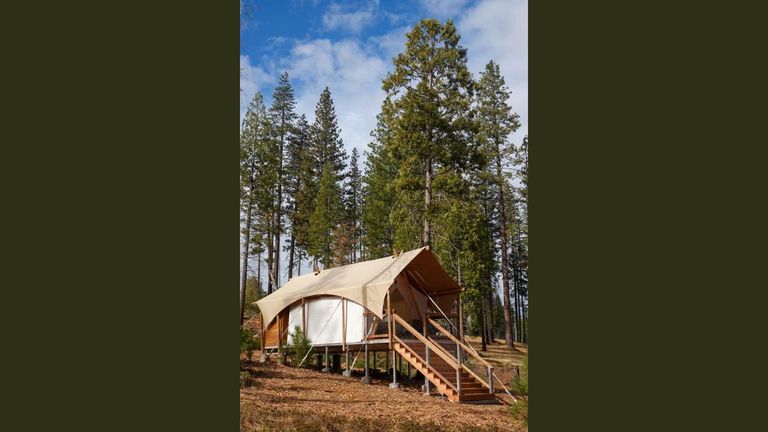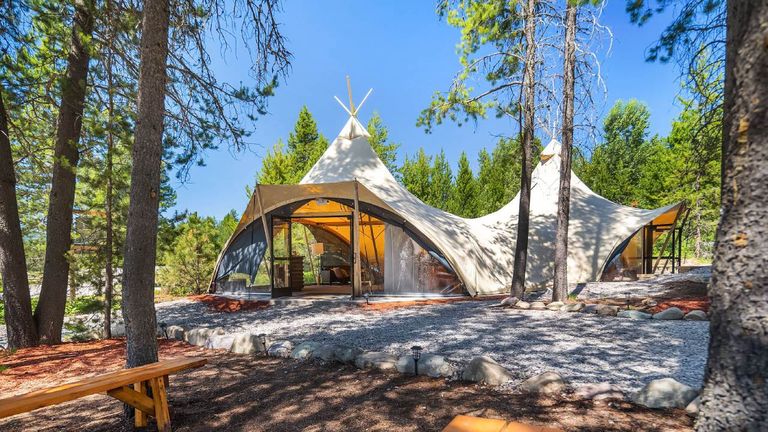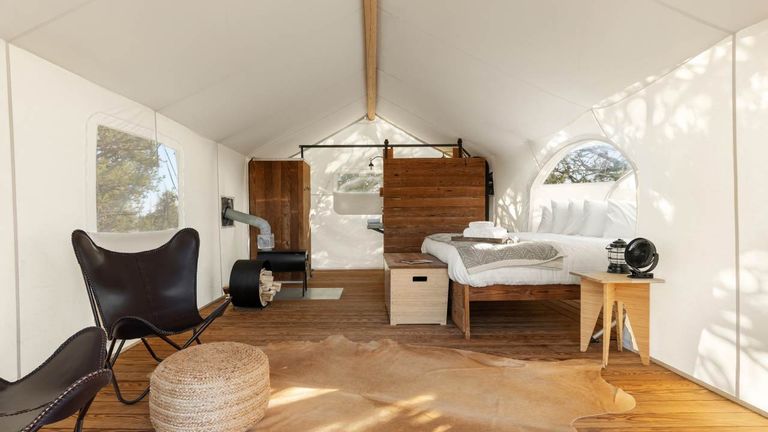It's a big year for Under Canvas, with two new glamping sites in incredible locations joining the portfolio: Under Canvas Yosemite in California and Under Canvas Columbia River Gorge in Washington.
As both a hospitality veteran and an outdoor enthusiast, Matt Gaghen, CEO of Under Canvas, is as excited about the additions as anyone. The new luxury camps are set in “distinctive outdoor markets” and aim to get guests unplugged and into the woods. Under Canvas Yosemite, an 80-acre camp just 10 minutes from a Yosemite National Park gateway, opens May 15. Under Canvas Columbia River Gorge is set in White Salmon, Washington, and offers easy access to rafting, paddleboarding, fishing, hiking, mountain biking and more.
 Matt Gaghen, CEO of Under Canvas
Matt Gaghen, CEO of Under Canvas
Credit: 2025 Under Canvas
Gaghen grew up in Montana, resides in Colorado currently and loves the natural diversity of the Western U.S. The seasonal sites of Under Canvas offer a “resort, leisure-oriented experience, with upscale services,” he says. We spoke with him to learn more about the Under Canvas brand, from sustainability efforts to how it stands at the confluence of the luxury and outdoor travel segments.
As more brands enter the outdoor hospitality space, ostensibly drawing more people into fragile natural spaces, how does Under Canvas address, or consider, its environmental impact?
The way I see it, there have been evolutions of this market. I grew up in Montana and my dad was a ranger in Yellowstone, so we spent our whole summer in the gateway town. We saw traditional hotels, then there was the evolution to boutique offerings. Now, there's an appreciation for lifestyle-oriented amenities.
What Under Canvas is doing is different — and with a lower environmental impact. I think we have a unique and appealing product for people who want to travel to these places and appreciate nature. Rather than staying in a gateway town or a chain hotel, here's a chance to experience something like a camp environment, but with amenities and ease. It's approachable, and amidst the trees.
Then, from an environmental standpoint, we have pull-chain showers, which reduce [water waste] substantially — we use a fraction of the water that a traditional hotel would. And we’re on these large properties; Under Canvas Yosemite is on 80 acres, but our buildable envelope is only about 30%. So, it’s a lighter impact and minimally disruptive relative to traditional development. We do things in a way that's much more environmentally sensitive, while also connecting people to nature.
Under Canvas is a family-friendly brand. Who else do you see booking, and when?
When school’s out, we see a lot of families traveling together, yes. In the shoulder seasons, it’s groups of friends and empty nesters. About 30-40% of guests are there with kids during the summer.
 Under Canvas Yosemite is one of two brand-new sites for the glamping brand in 2025.
Under Canvas Yosemite is one of two brand-new sites for the glamping brand in 2025.
Credit: 2025 Under CanvasYosemite National Park is one of the most-visited parks in the U.S. What can clients expect from the new Under Canvas location here?
It is stunning, and something we've been building for a while. It’s about 10 minutes from the Groveland park entrance and nestled in these beautiful pines. So, it feels very much of the place. And our product is well positioned — it’s a natural, John Muir-type camp experience. It’s spread out, with an amphitheater-like layout and a central lobby with a yoga deck.
Our tents are on elevated decks, and that makes for a kind of treehouse effect, since the landscape is sloped. From there, guests have incredible views of the natural beauty around them. The tents are ensuite accommodations, so bathrooms are connected to each individual one, and we used natural woods and polished concrete basins in them. I think people are going to love it. The tents are such a comfortable, safari-inspired experience.
How does Under Canvas help guests get off site and into the park?
First of all, we offer access. We have a YART [Yosemite Area Rapid Transit] shuttle stop right at the base of our entrance, and we're one of the last stops going to the park and one of the first coming out.
Then, we offer all sorts of adventures through our experience coordinators. We have a very active guest profile, and our experience coordinators help guests set up everything from rock climbing and fly fishing to whitewater rafting and stargazing. We have vetted third-party partners who, in many cases, will come pick customers up right at the camp. Working with these local operators means you get insider views of the area, and you're getting dollars in the local economy, too.
 Under Canvas Glacier gives clients easy access to Glacier National Park.
Under Canvas Glacier gives clients easy access to Glacier National Park.
Credit: 2025 Bailey MadeLet’s talk about the brand’s other new property for 2025: Under Canvas Columbia River Gorge. What should clients know about it?
Columbia River Gorge is gorgeous. We have 120 acres there with beautiful trees and massive views of Mount Hood. The camp is outside of White Salmon, Washington, and about 20 minutes from the Hood River in Oregon. Recently, someone told me about the five “Ws” of Hood River: wineries, waterfalls, wind sports, whitewater rafting and wildflowers. So, while it’s not a national park, it's a great outdoor destination with great wine and culinary options, too.
I can't think of anybody who has as much beautiful land as we do, and we think the natural elements are luxurious in their own right.
 The interior of a Stargazer tent at the new Under Canvas Columbia River Gorge in Washington
The interior of a Stargazer tent at the new Under Canvas Columbia River Gorge in Washington
Credit: 2025 Under CanvasWhat exactly brings the “glamour” to Under Canvas’ glamping product, beyond the furnished tents? Or, what can advisors tell clients who are wary of the level of comfort a property might offer?
First, I think what differentiates us from competitors is that acreage I’ve talked about — I can't think of anybody who has as much beautiful land as we do, and we think the natural elements are luxurious in their own right. It's quiet, you have big views and natural features around you. Other brands provide accommodations, but they are typically oriented around access, like a larger road or even a freeway. We find places that are a little bit removed and integrated into nature. Sometimes very high-end luxury resorts offer this, too. We're upscale, but we're not out of reach for people in terms of price point.
Then we have our distinctive accommodations, of course — you’ll hear birds chirping, coyotes howling or owls hooting from your safari-style tent. With this great backdrop, we also provide great food. We have cafe-style dining, which allows you to enjoy comfort food onsite, from a bison burger to a Nicoise salad. We have gluten-free and vegan options, too — and none of this is all that easy to pull off in a remote outdoor location. So, we're not just a product, we're an experience.
Then, a big part of our positioning is embracing nature in the night sky. We’ll have drinks on the deck for adults, even fun themed cocktails, while the kids are making s’mores by the fire. People come with a camping mindset, but they're expecting a boutique experience, and that’s what we give them.
Given that, how do you describe the Under Canvas guest?
People with an adventurous mindset will love us. I think there is a misconception that [our camps] are rugged and just for people who are very outdoorsy. But we offer comfort in nature. We have a lot of guests who are looking to explore, and maybe they've never spent time in the woods. We want them to know what to expect, including consistency of service and a reliably good time.
Then, we are for both the traveler who wants to disconnect and the traveler who wants to be social. Under Canvas Bryce Canyon, for example, is on 750 acres of land — you will feel disconnected. But if you want to go down to the social area, you can certainly do that.
How does Under Canvas work with travel advisors?
As we've “grown up” — we have 14 locations this year, and we'll announce more soon — we've embraced the travel community in a bigger way. When you’re small, you're scrappy and you’re building the product. But we're more mature now, and we have expanded our distribution strategy to be more in line with other hospitality companies.
We have embraced the travel trade in a few ways. First, Libby Rice, who used to be co-president of Ensemble Travel, has joined us. She's helping us with everything from the ease of booking to joining different consortia. She’s making sure agents are going to get their commissions across our channels, and that we provide support for agents. Then, we have a reservations team and our adventure coordinators who can help them organize and book experiences and accommodations. We really value the agency community, and we want to support them.
What we are finding is that the customers travel agents bring are typically looking to stay a little longer. They are looking to do more and spend more with us. But we want to make it easier for them to navigate that.